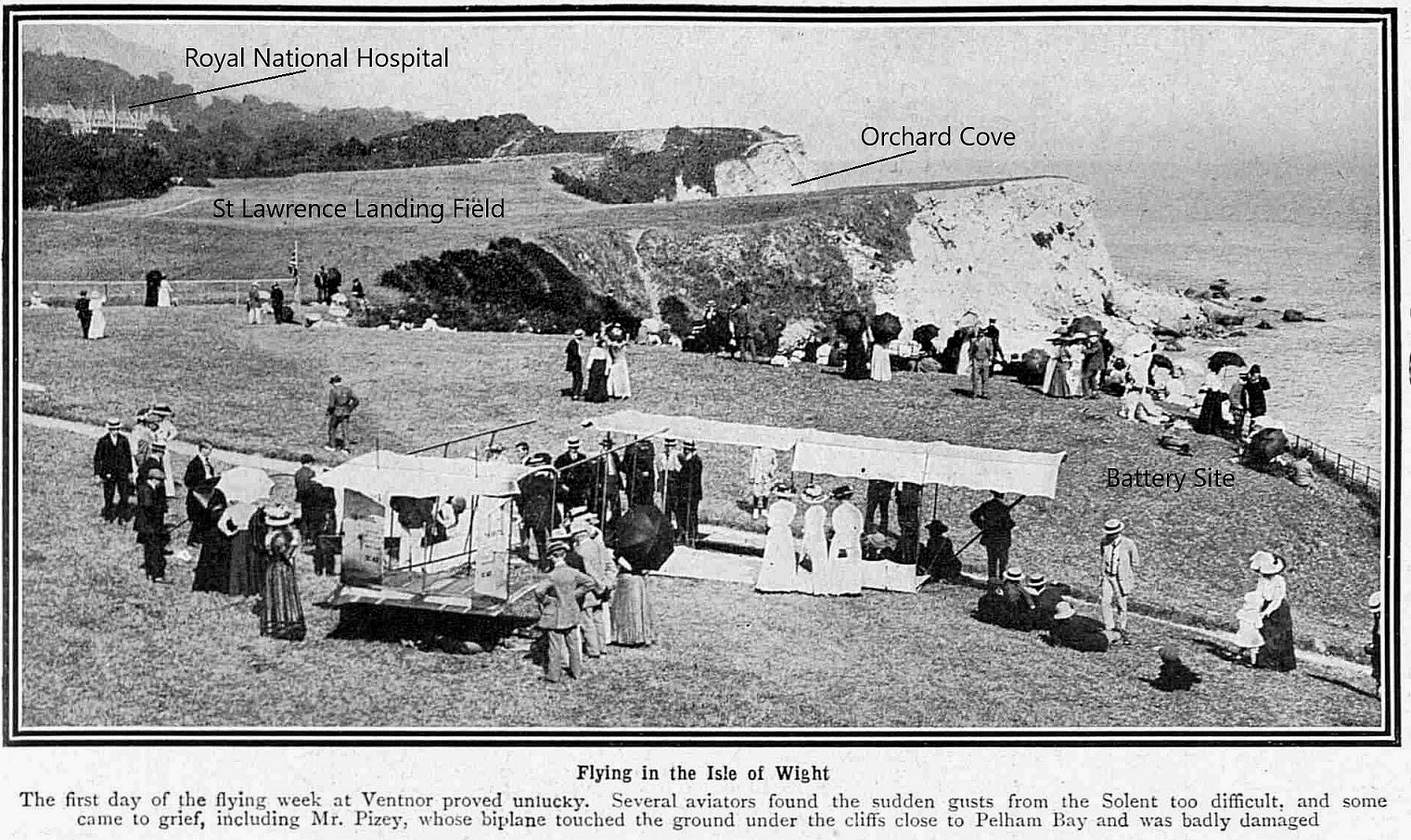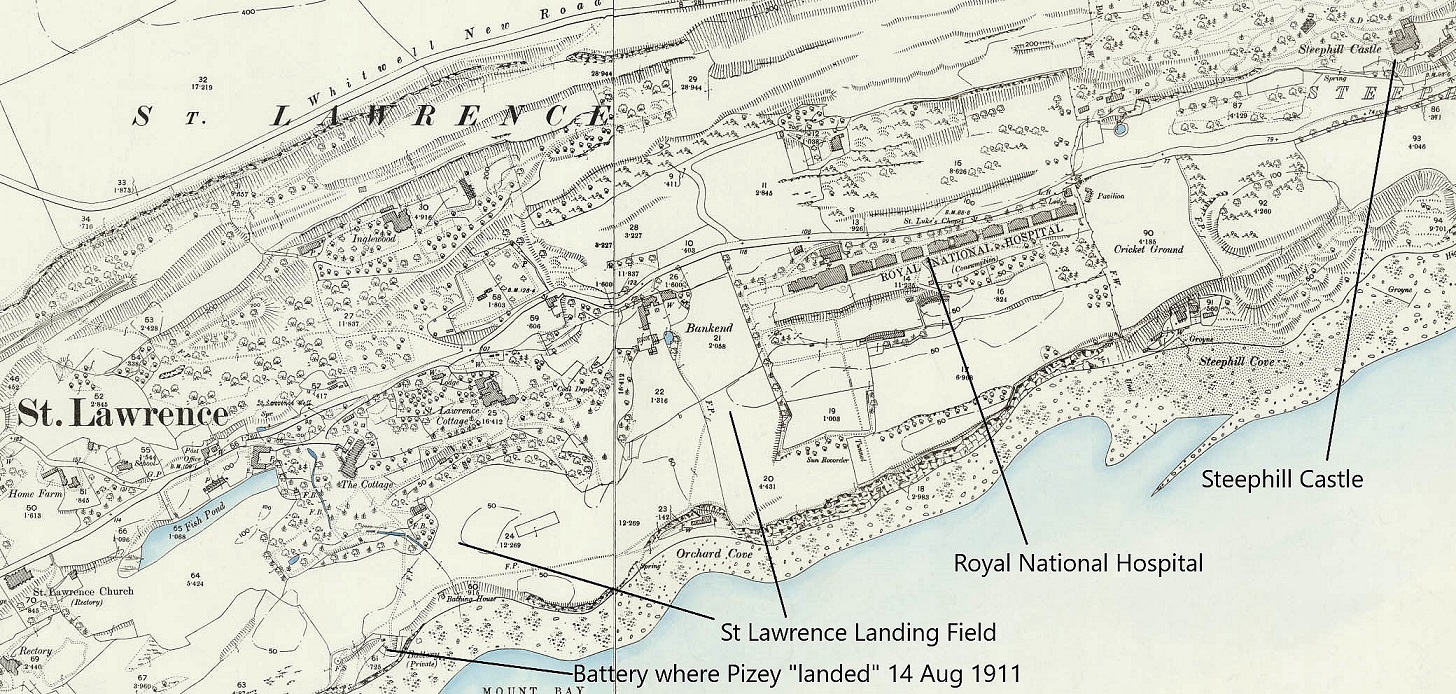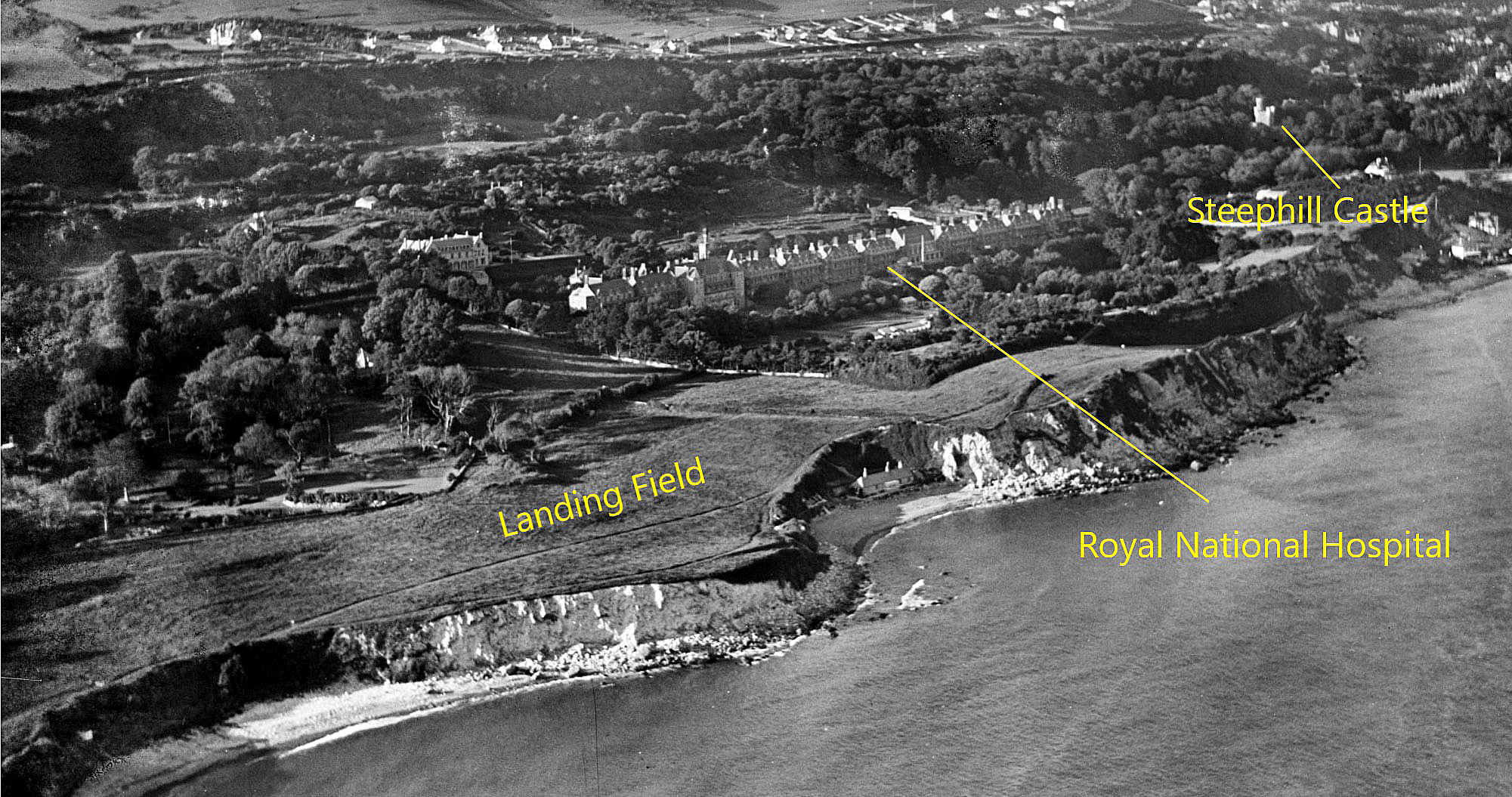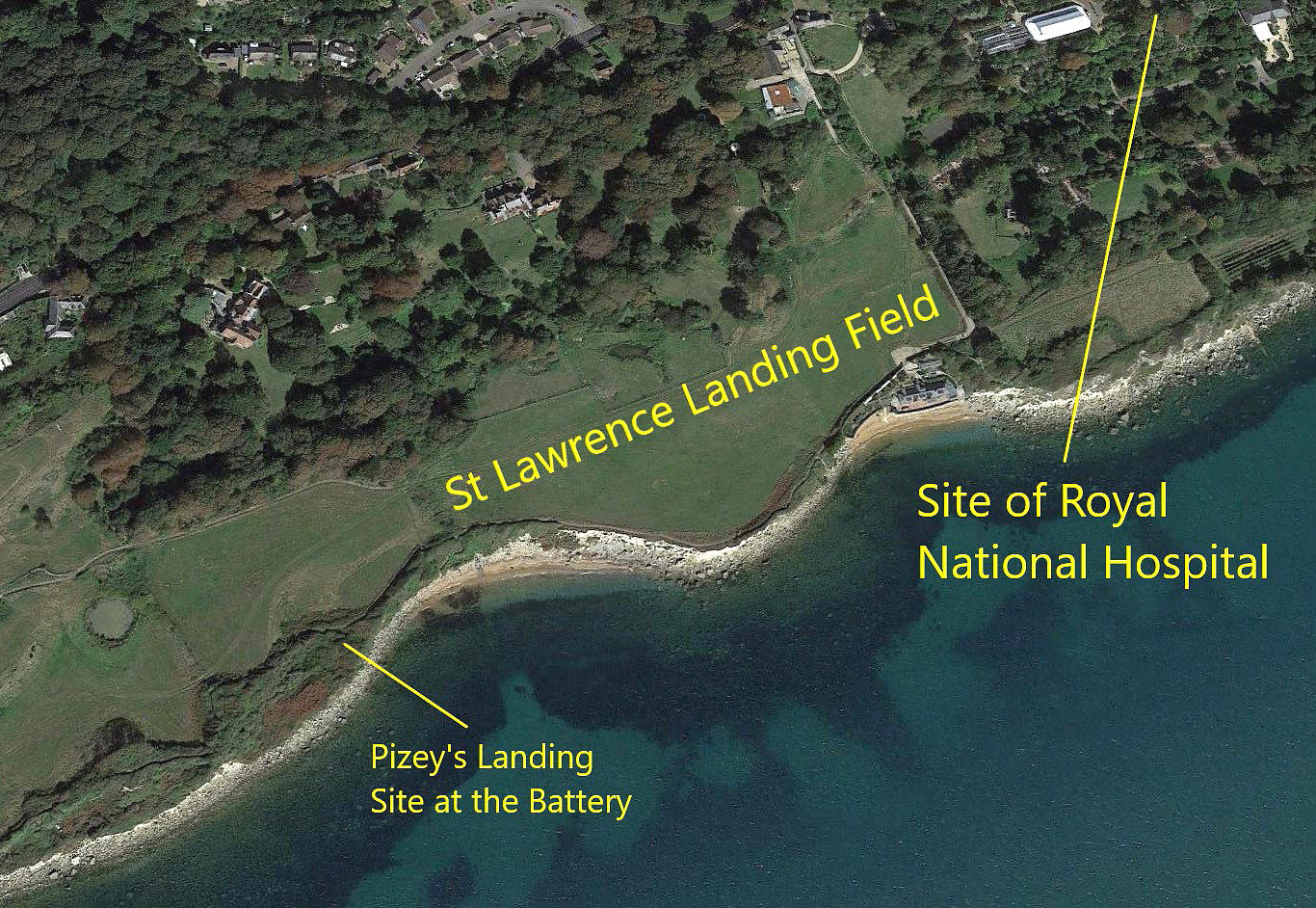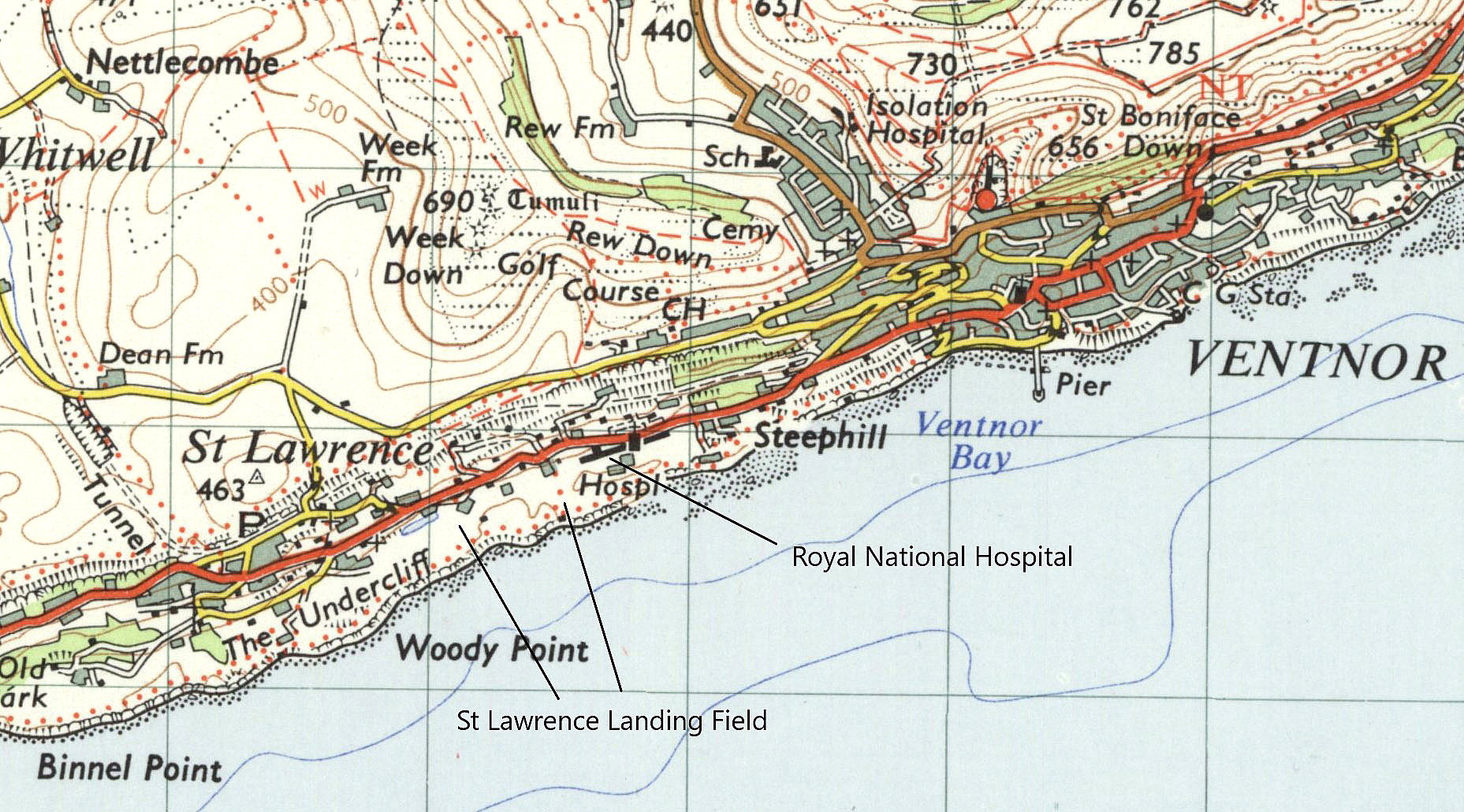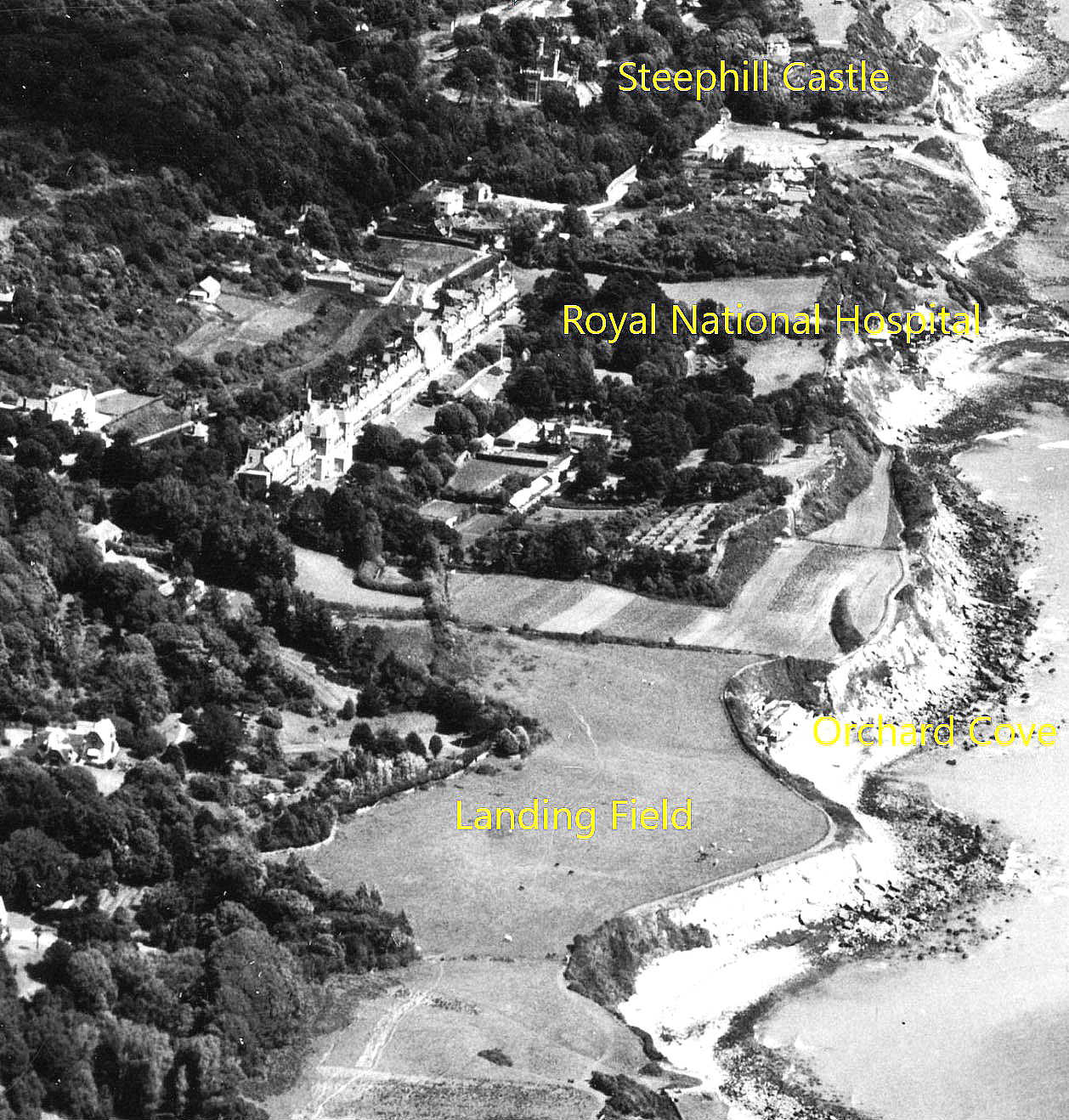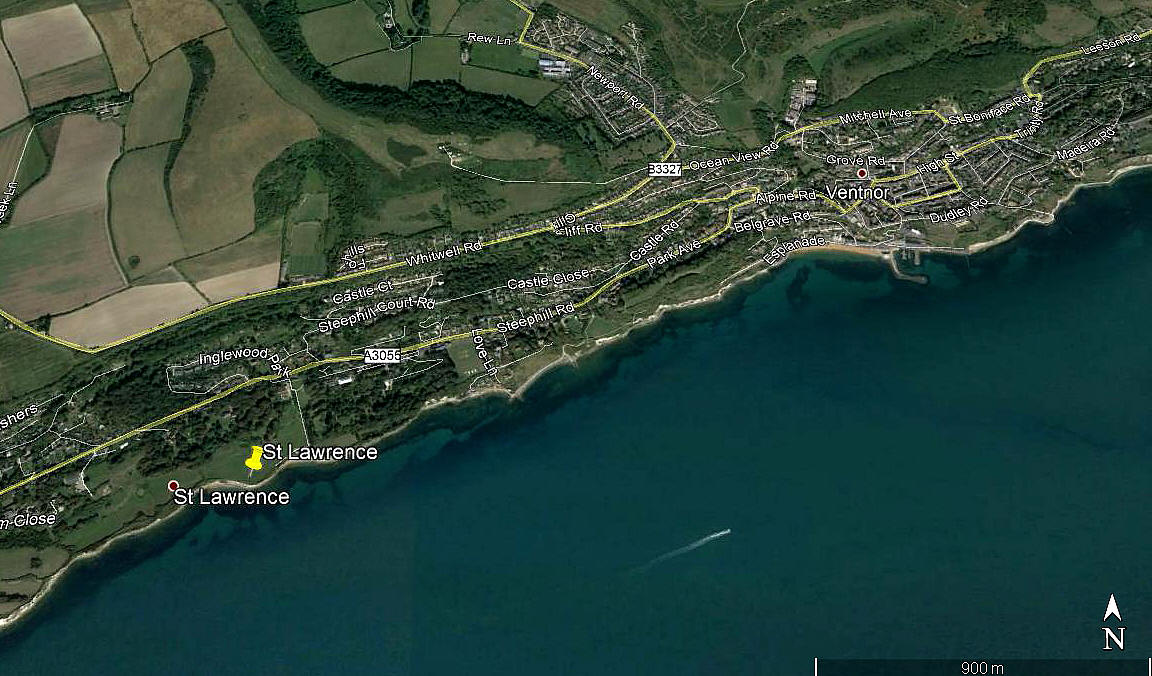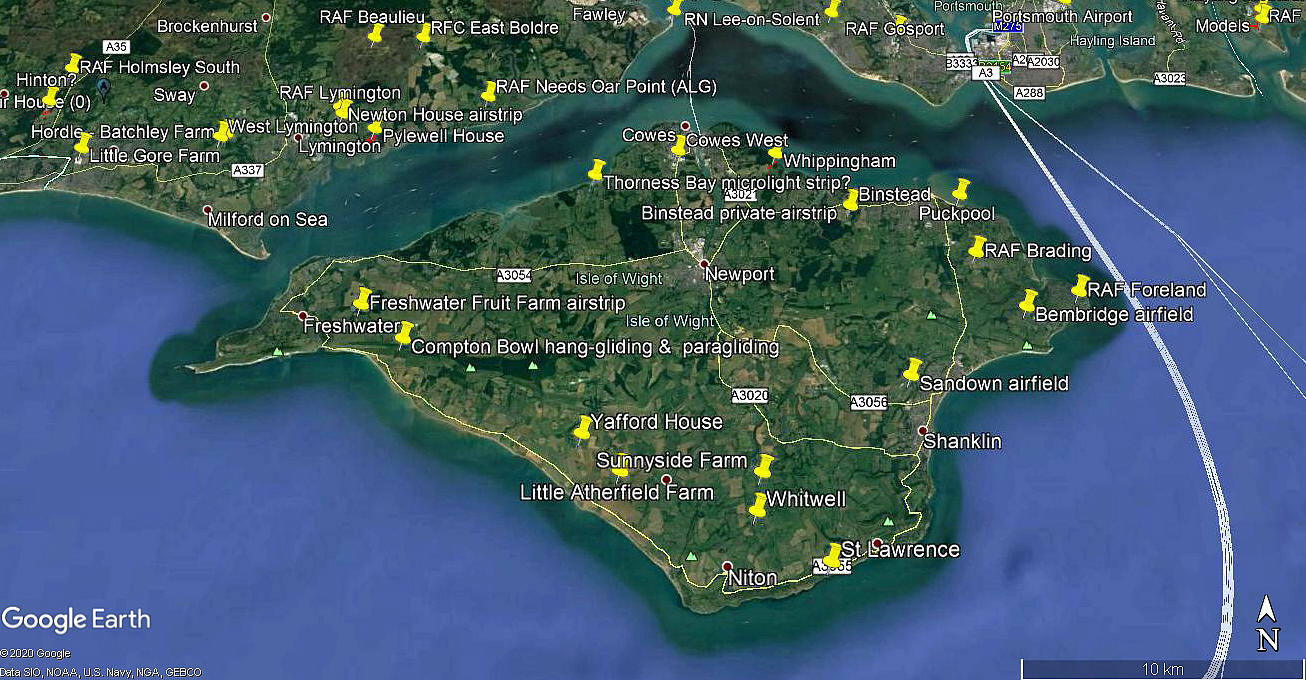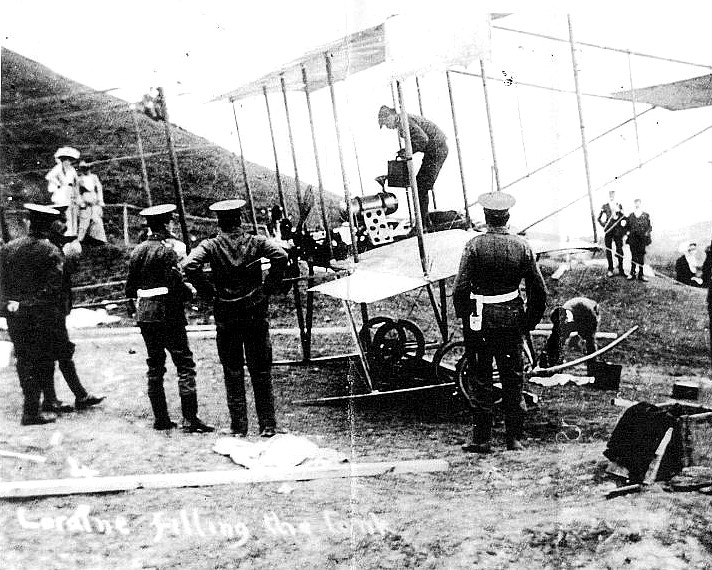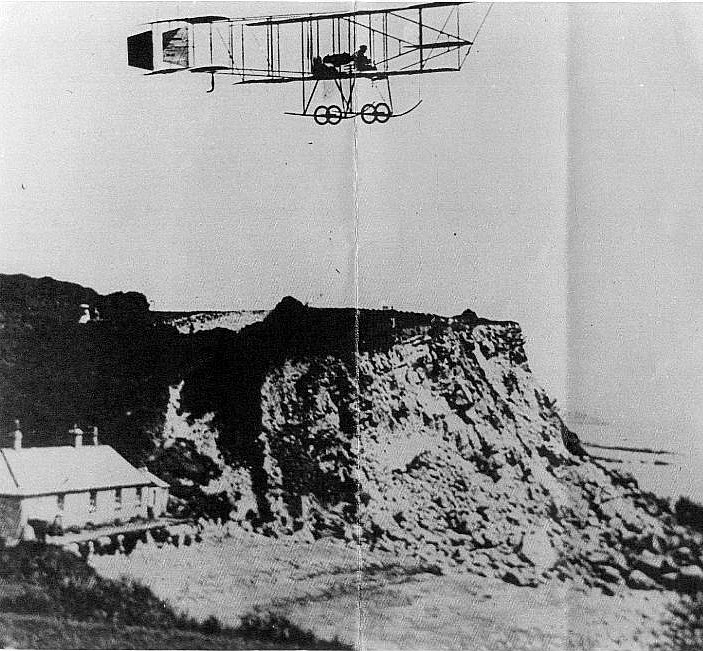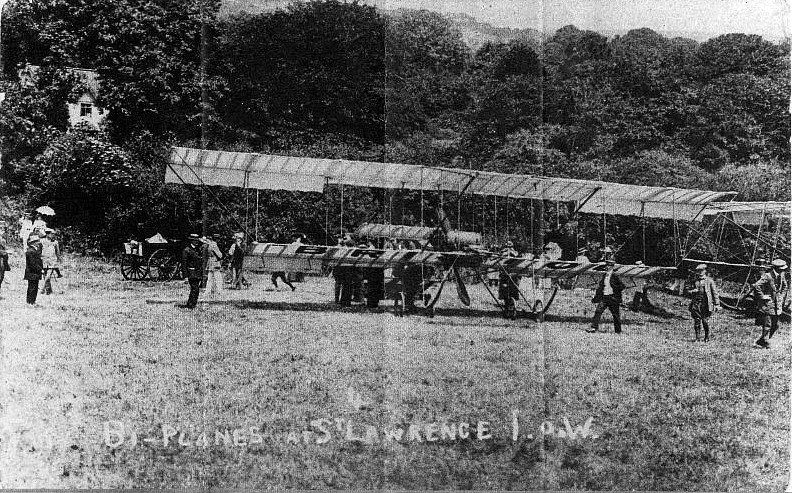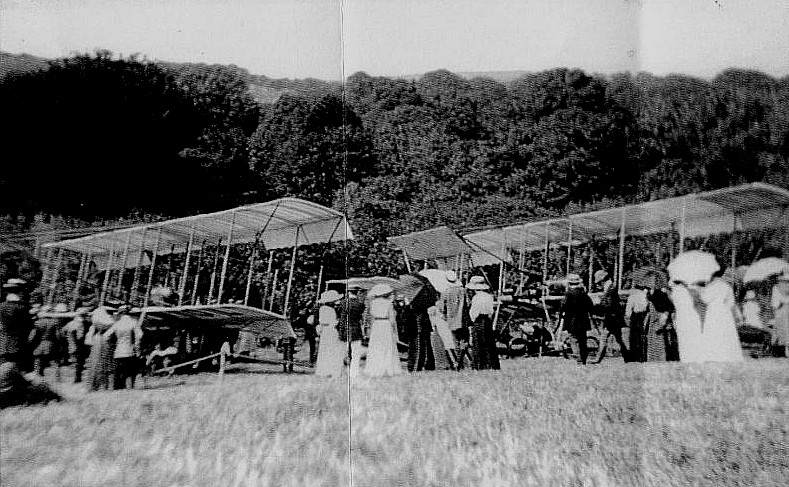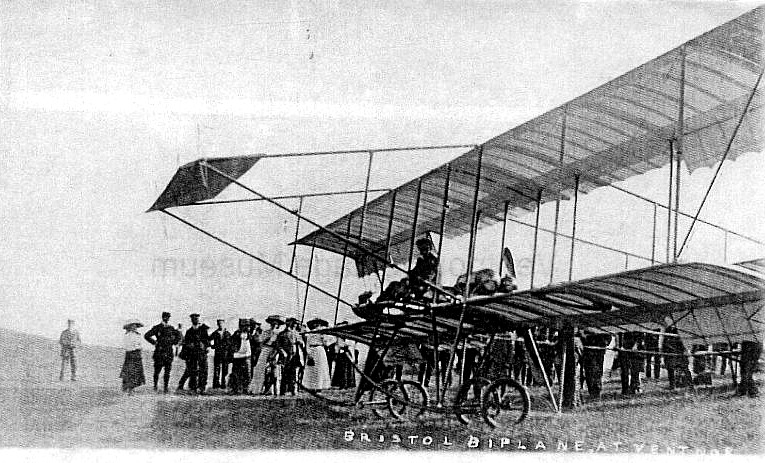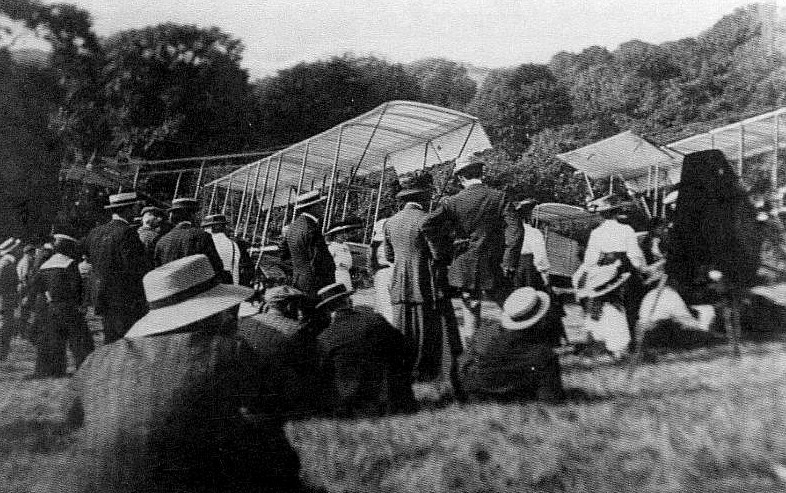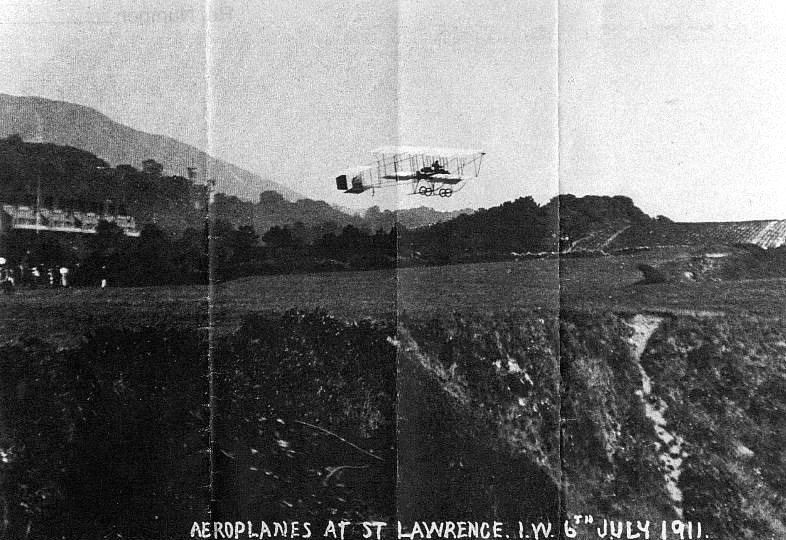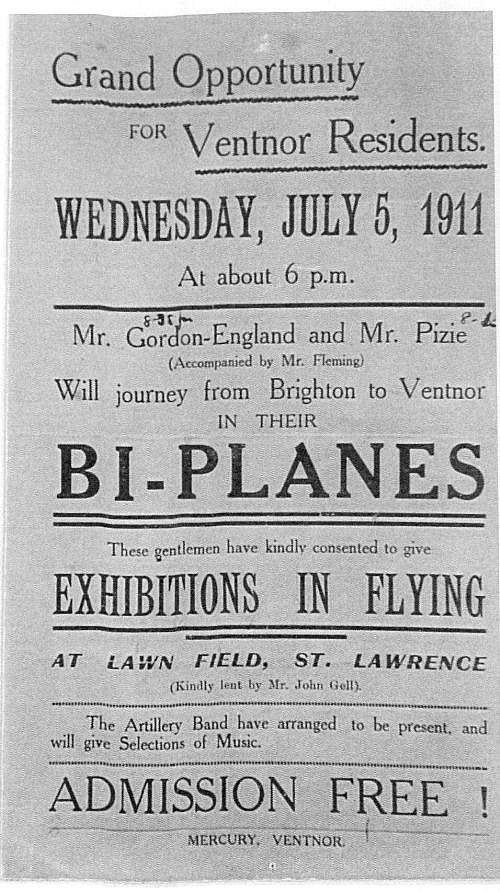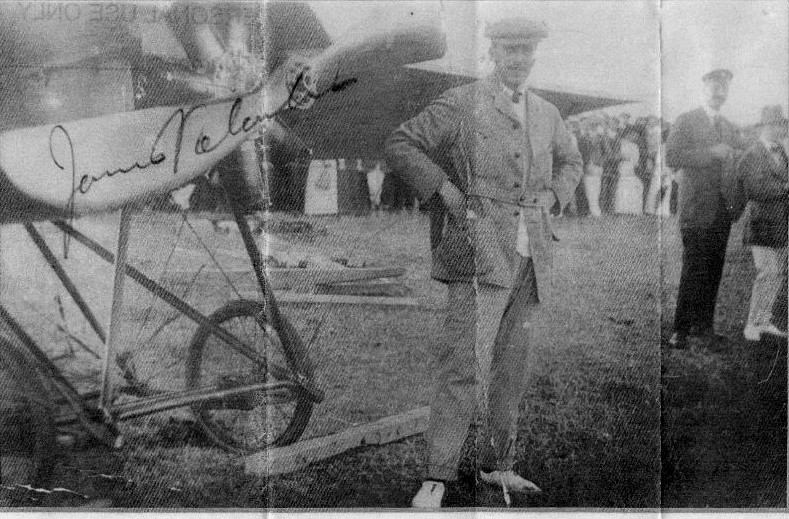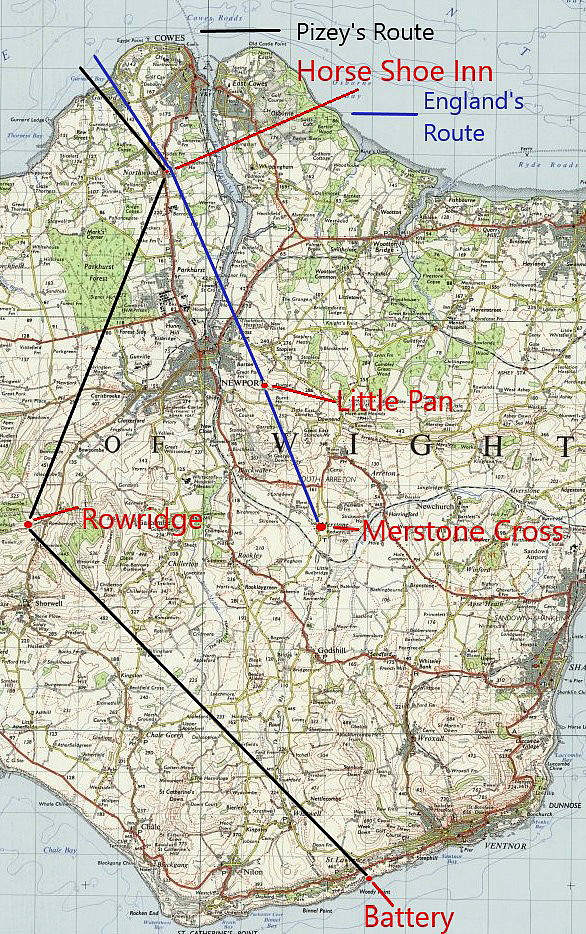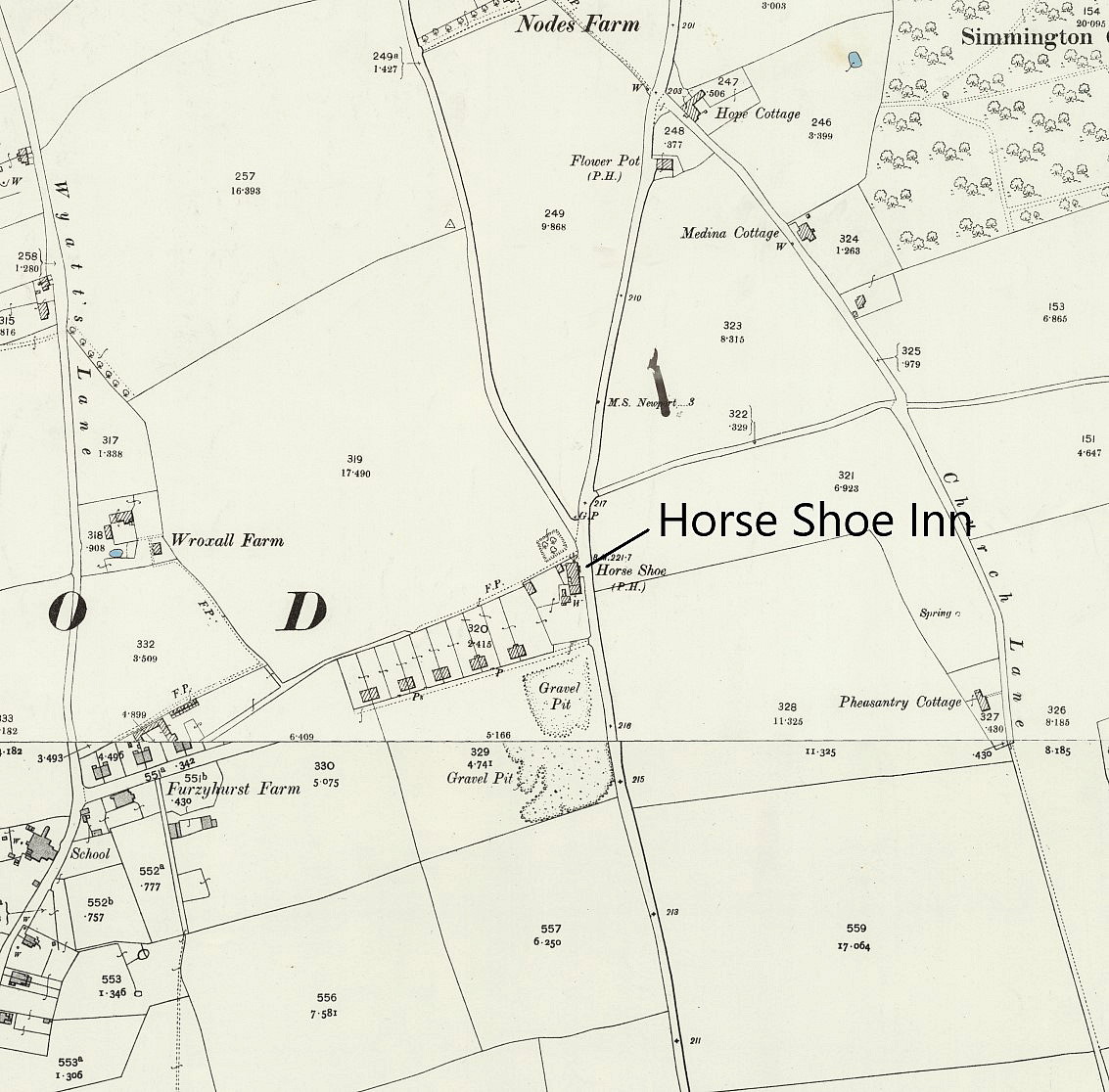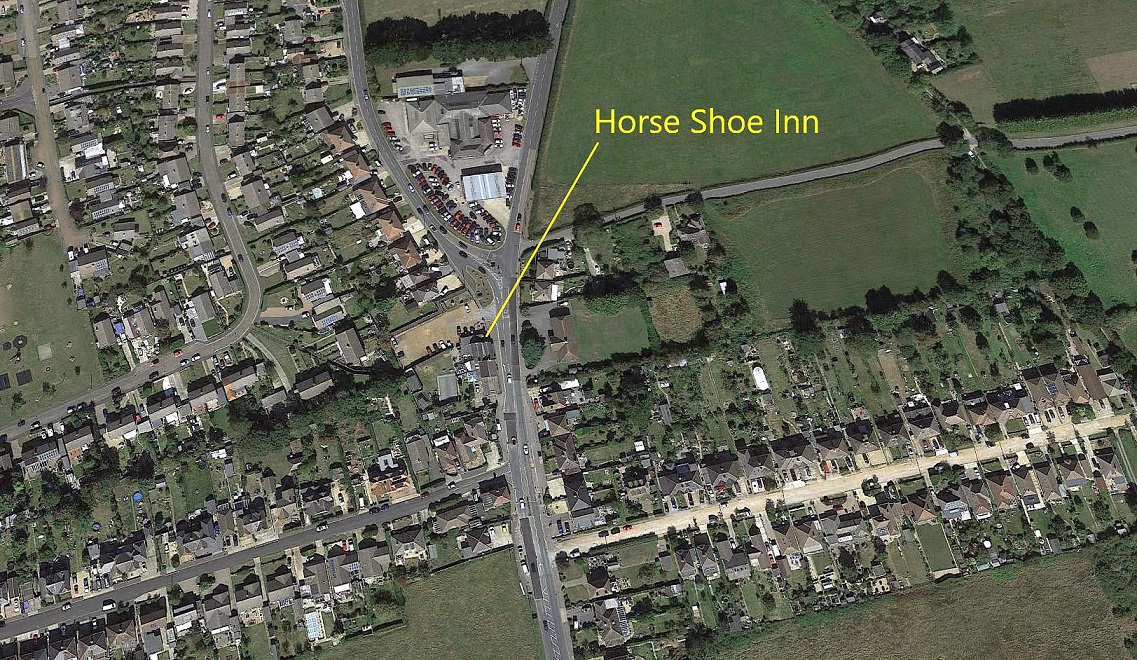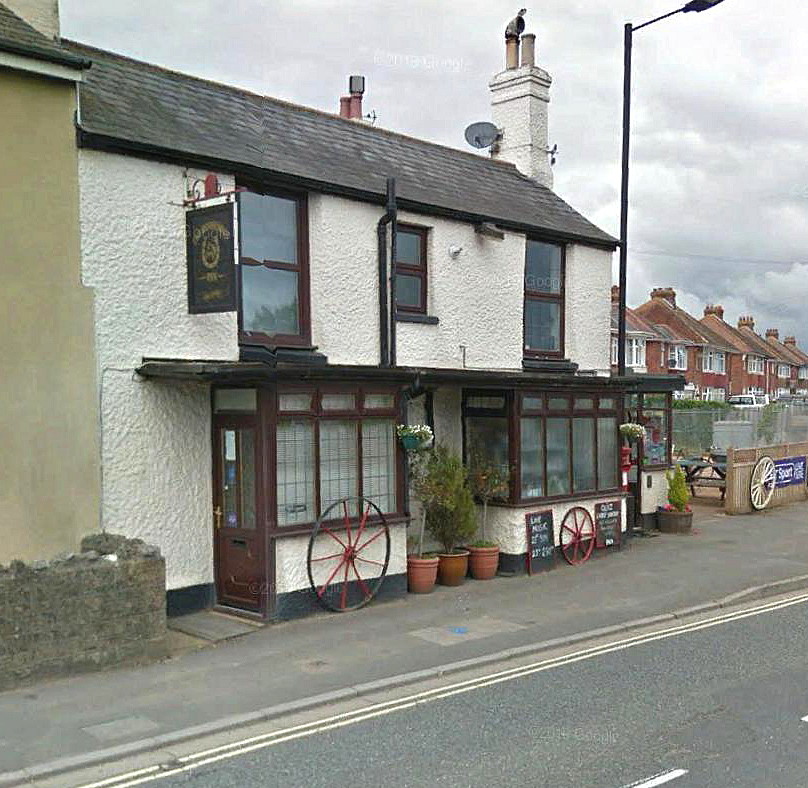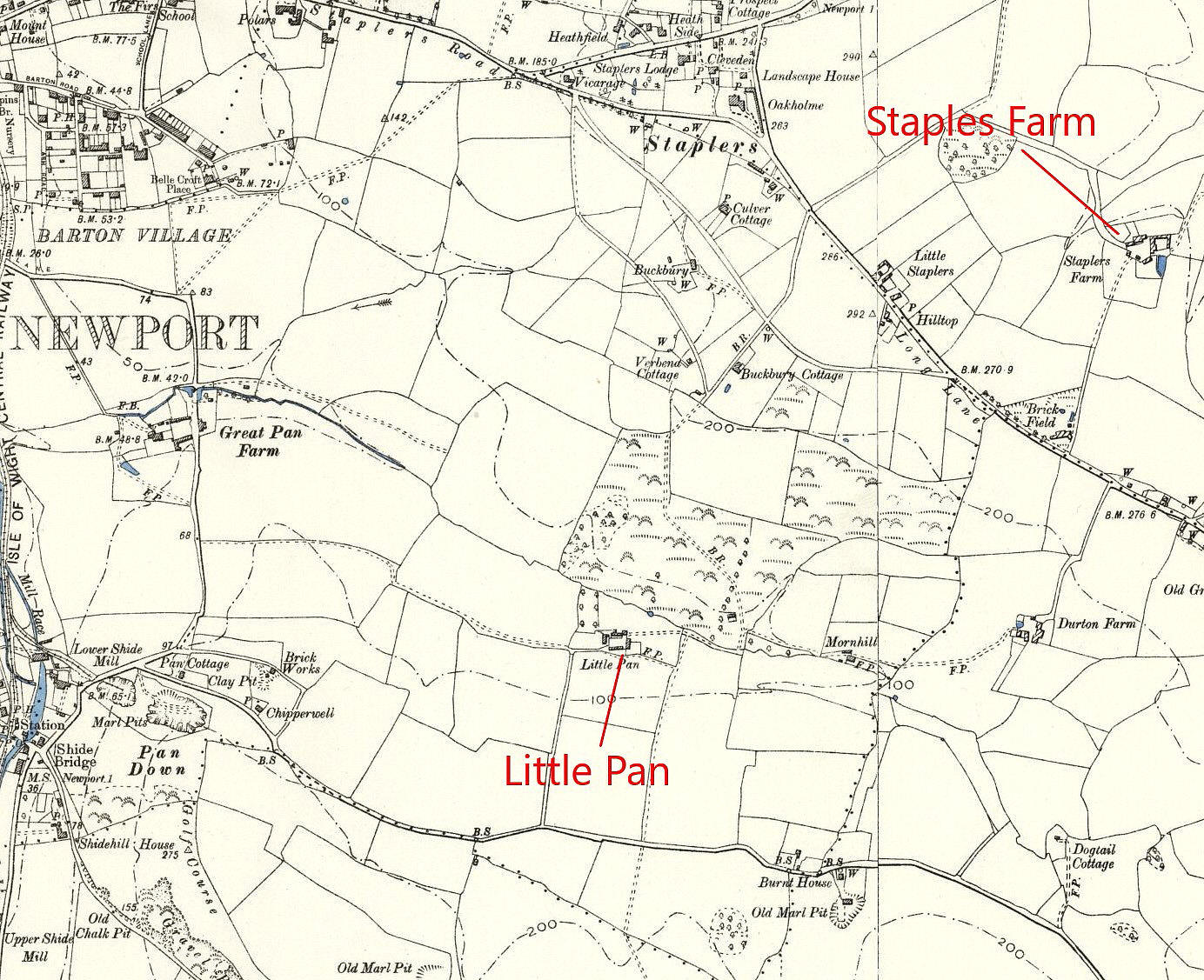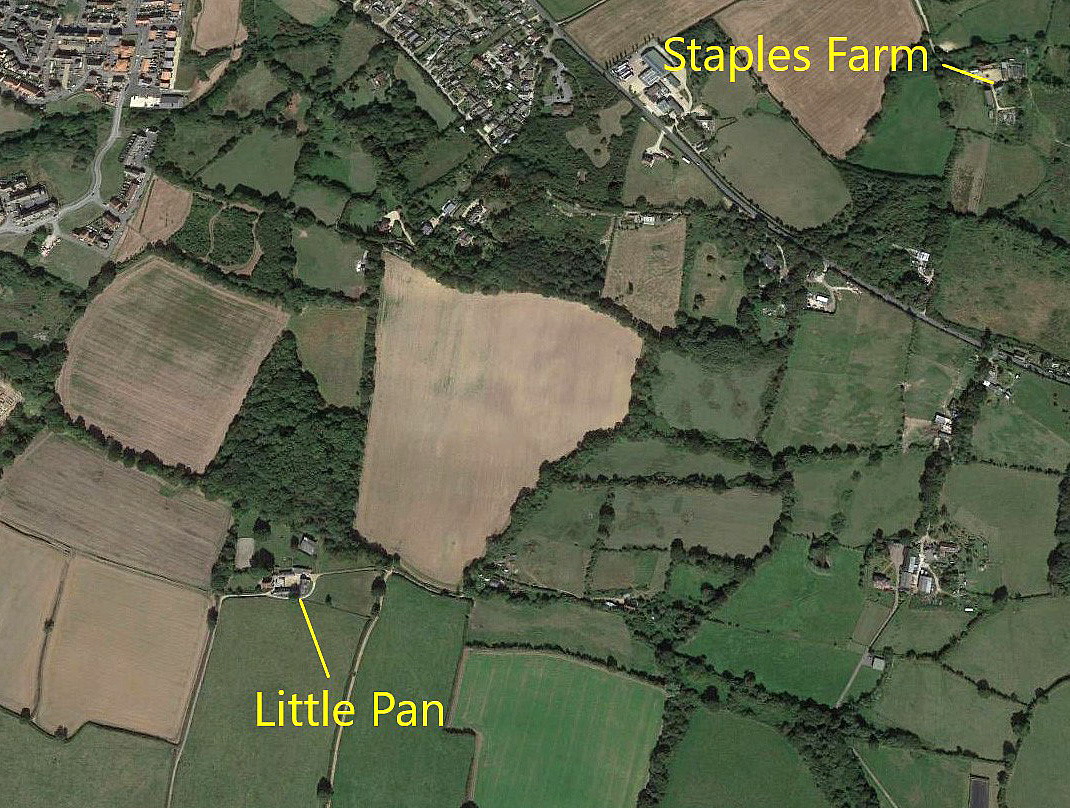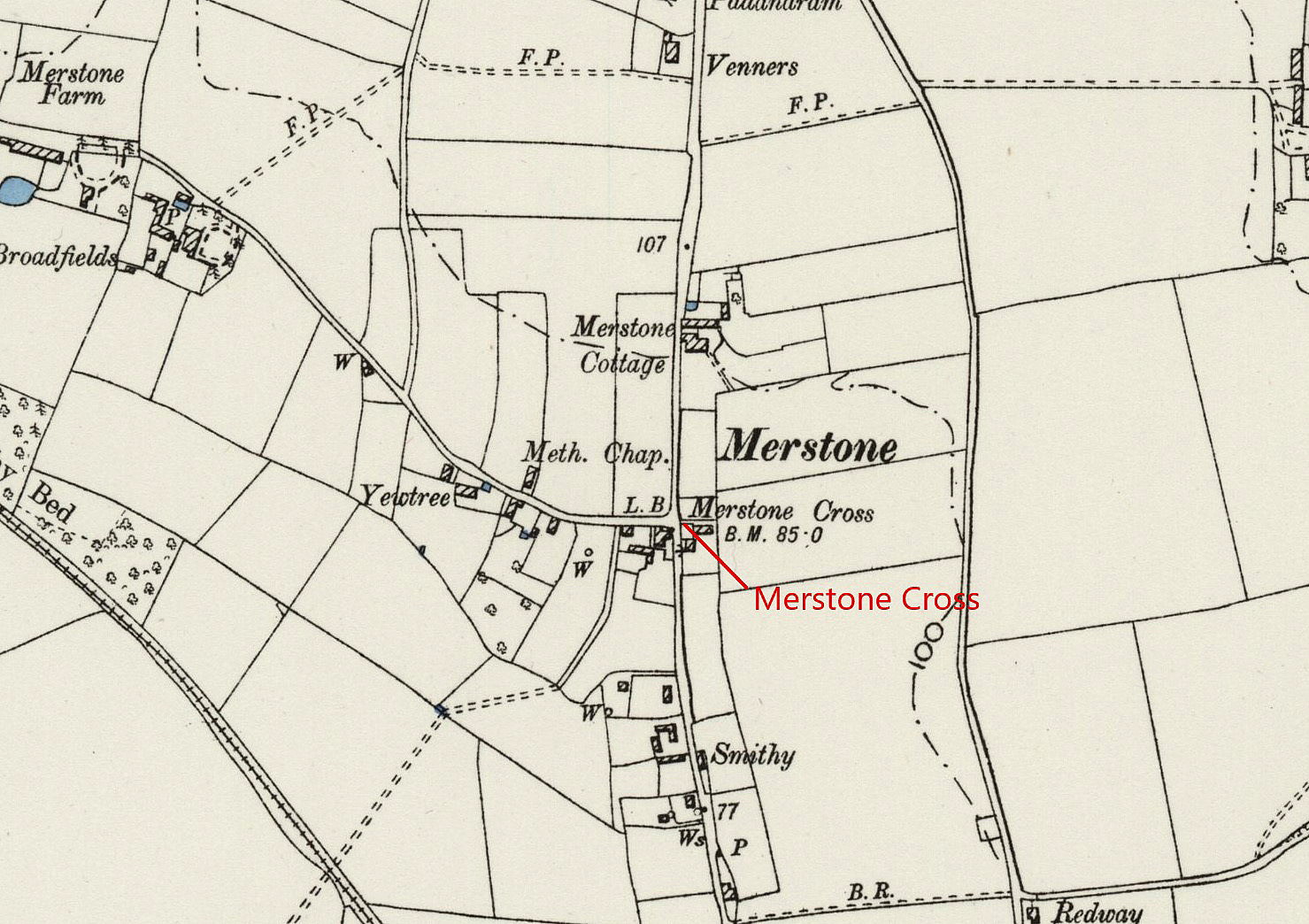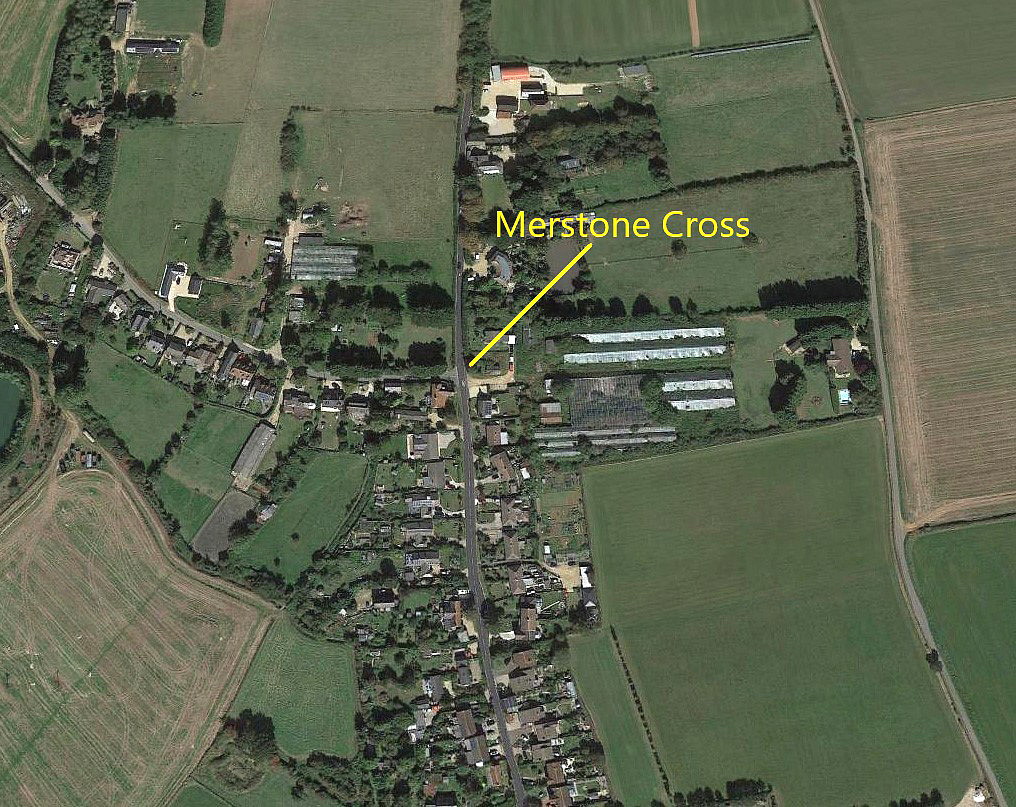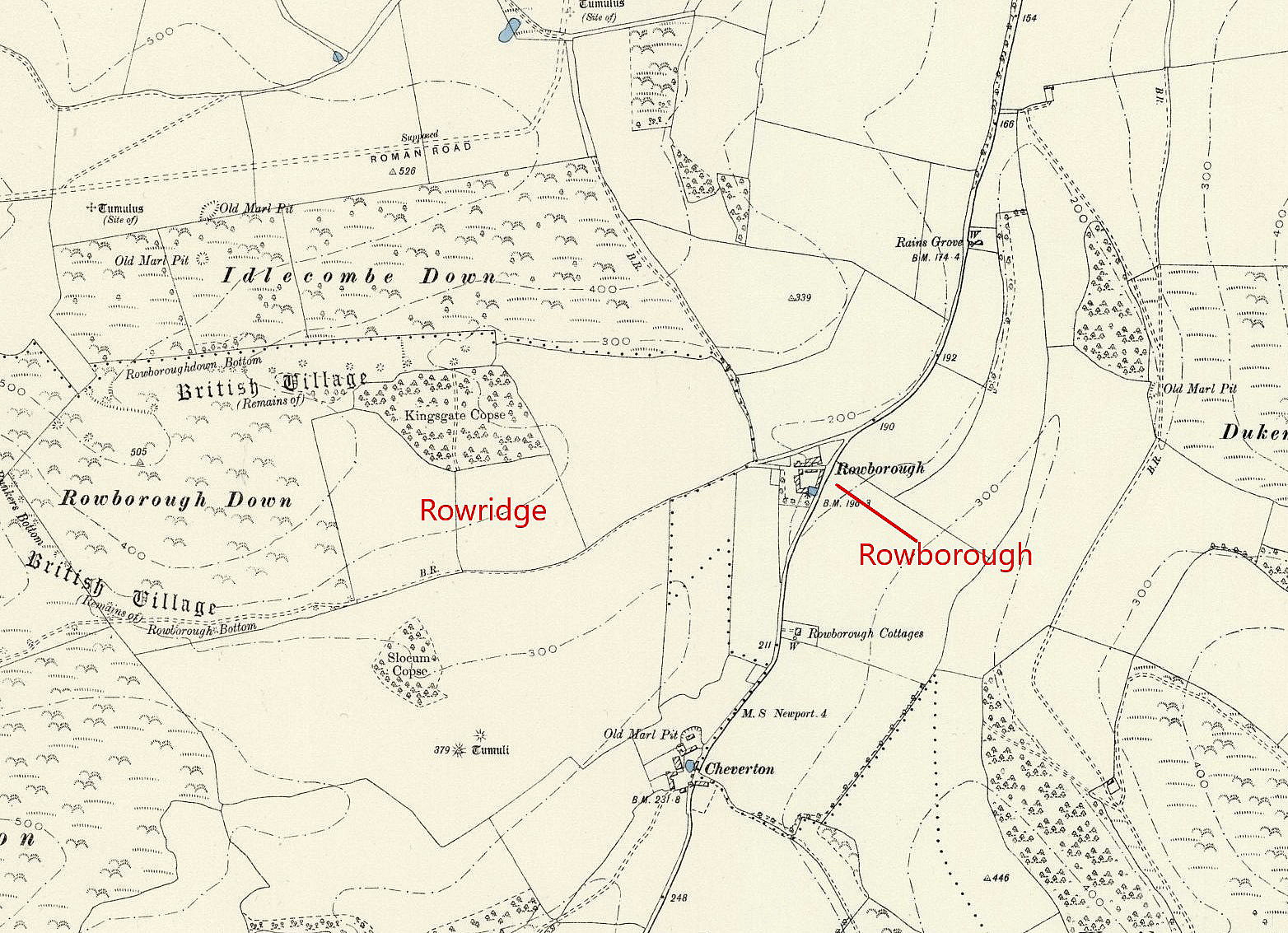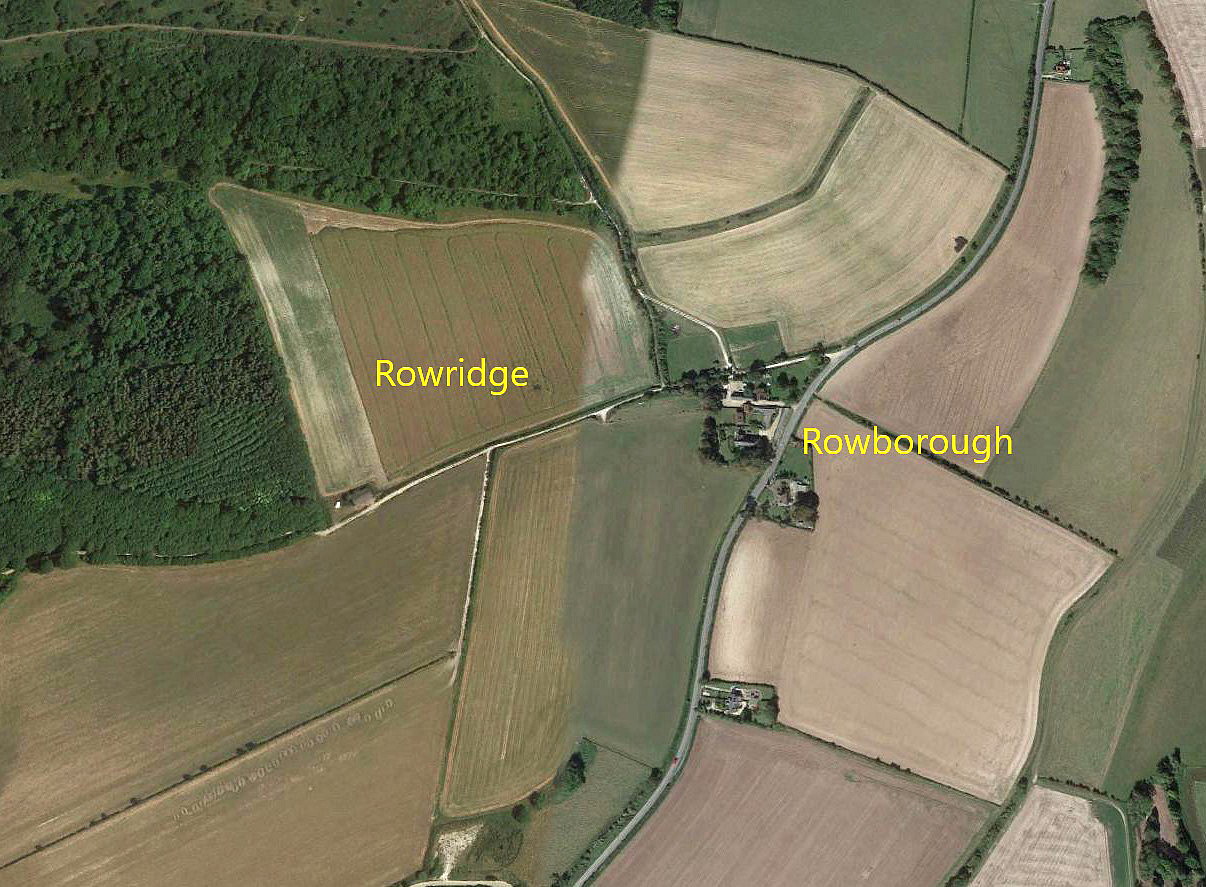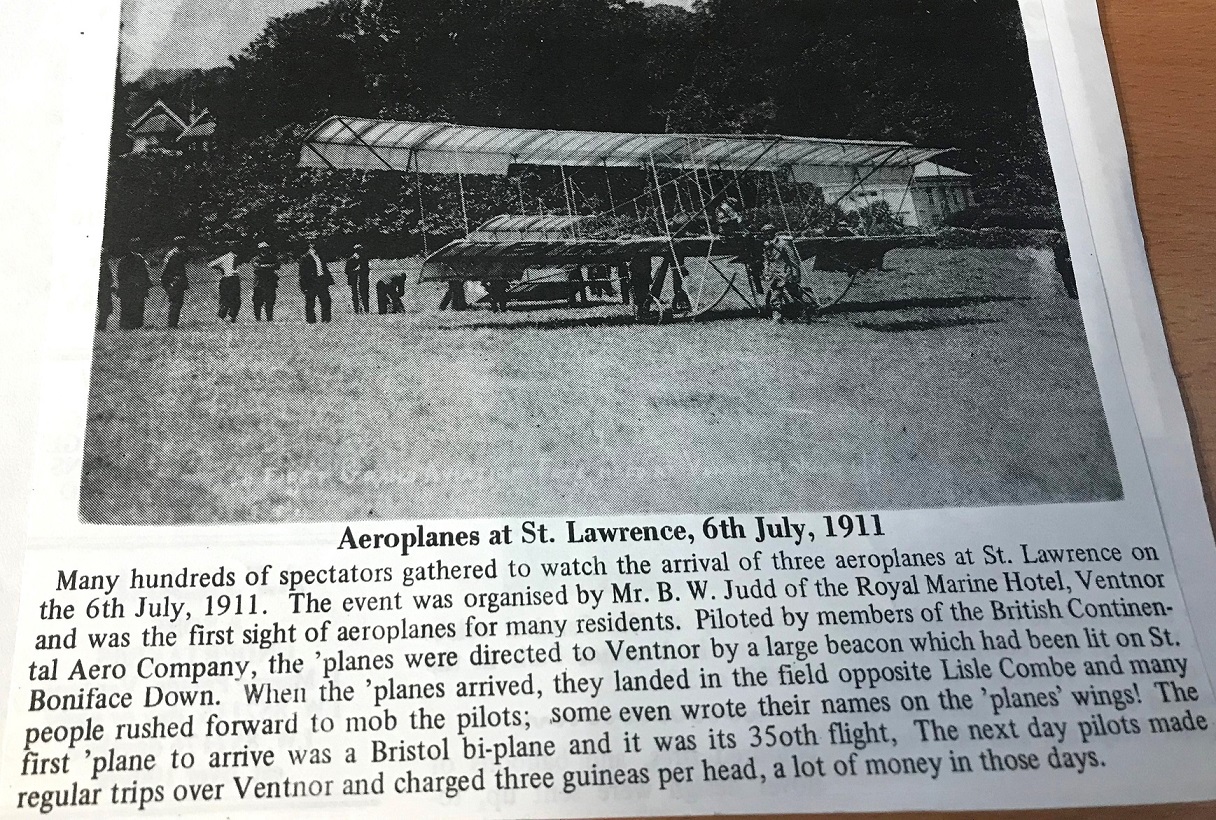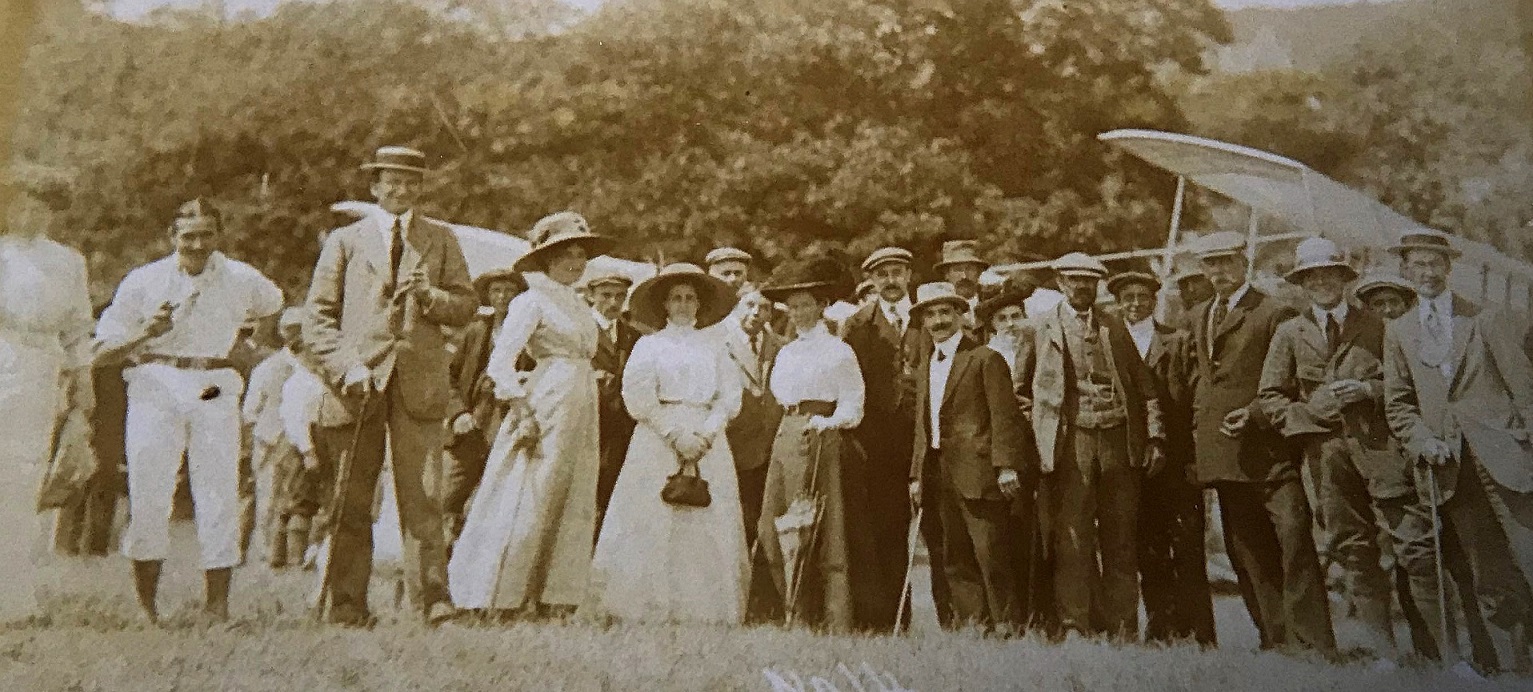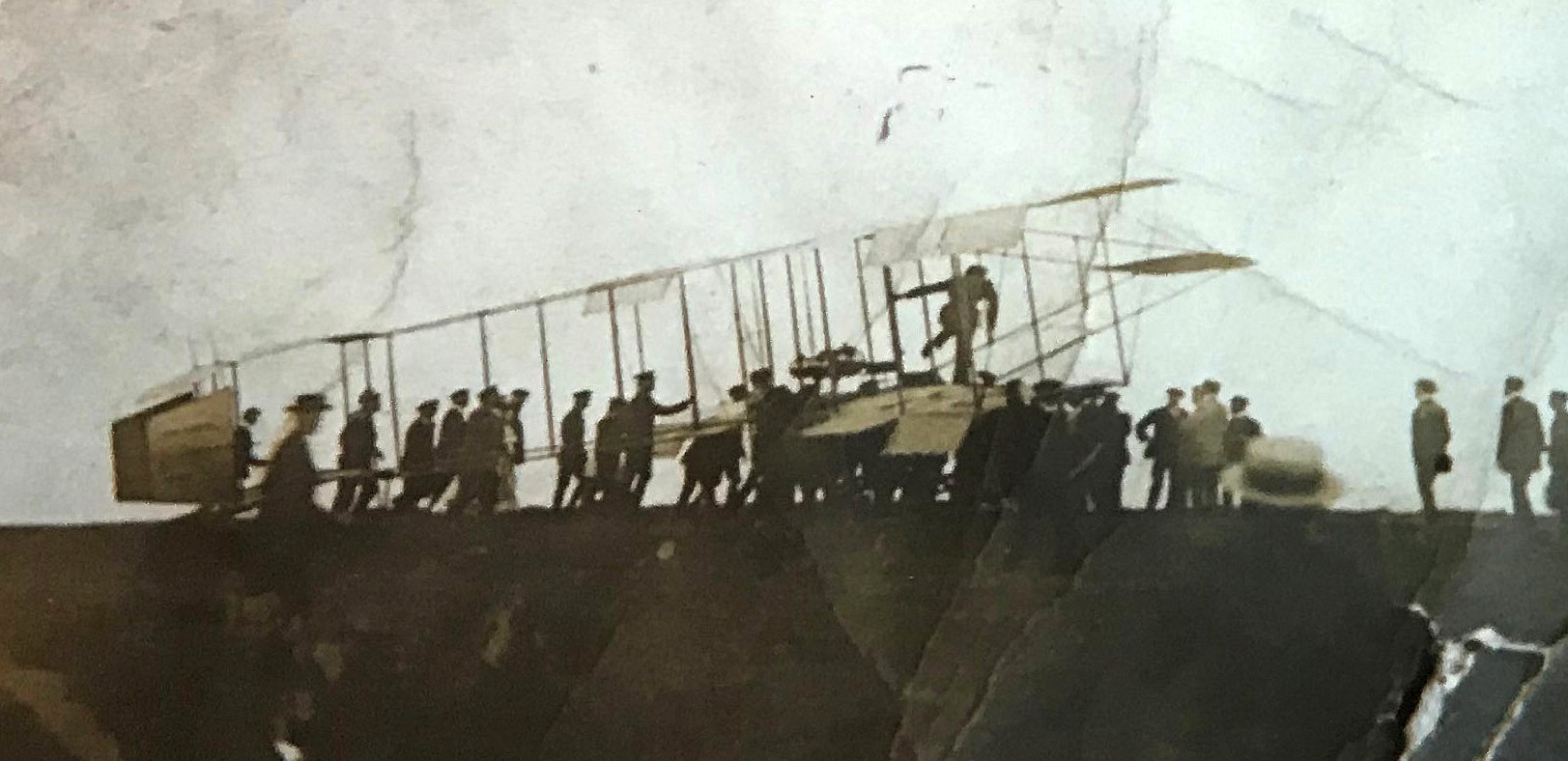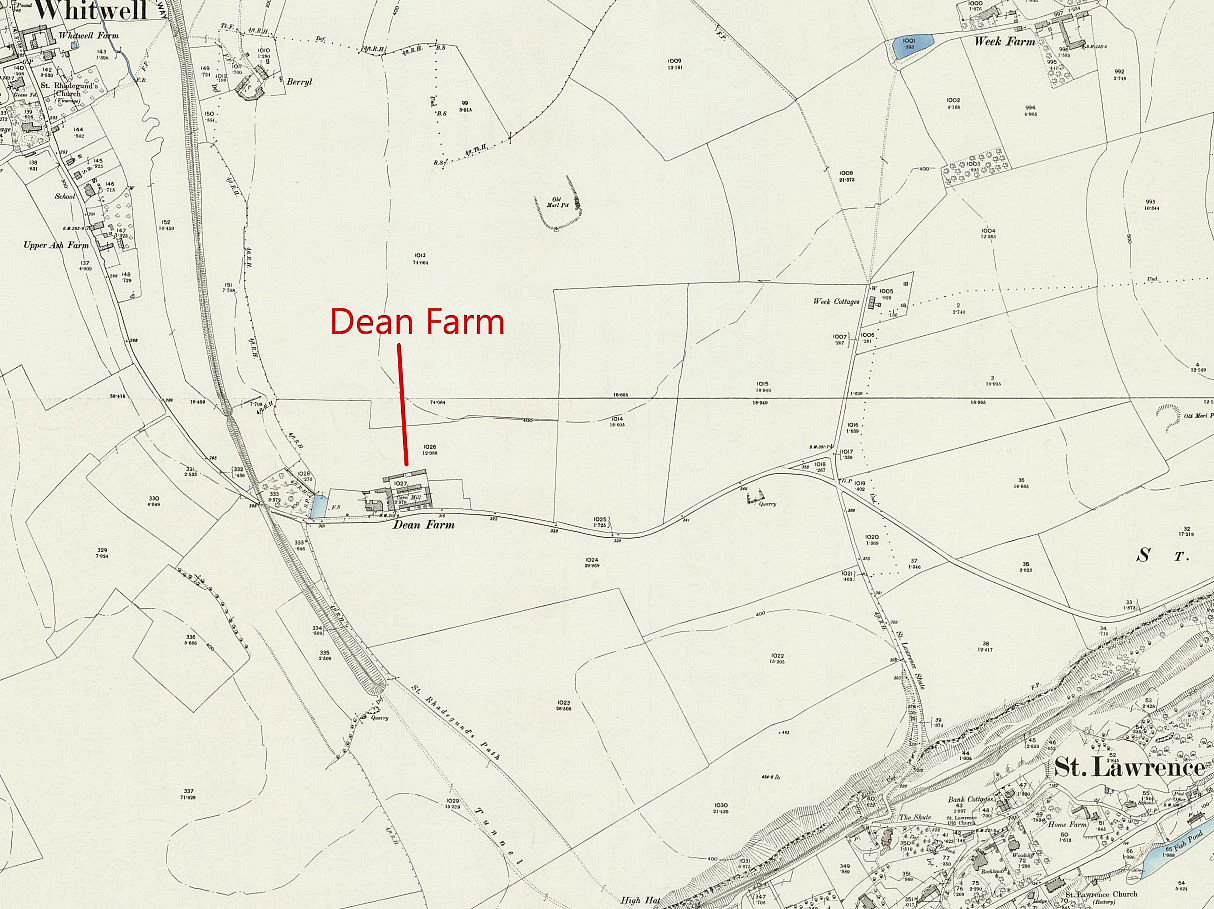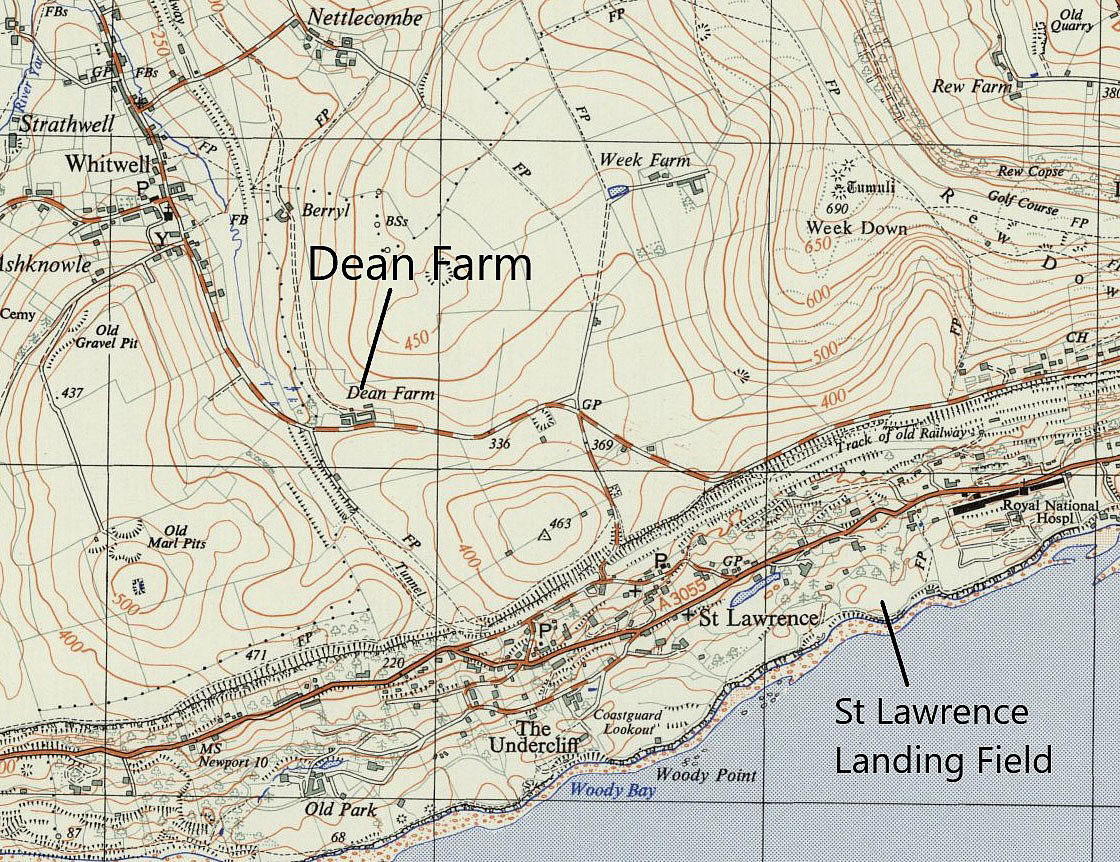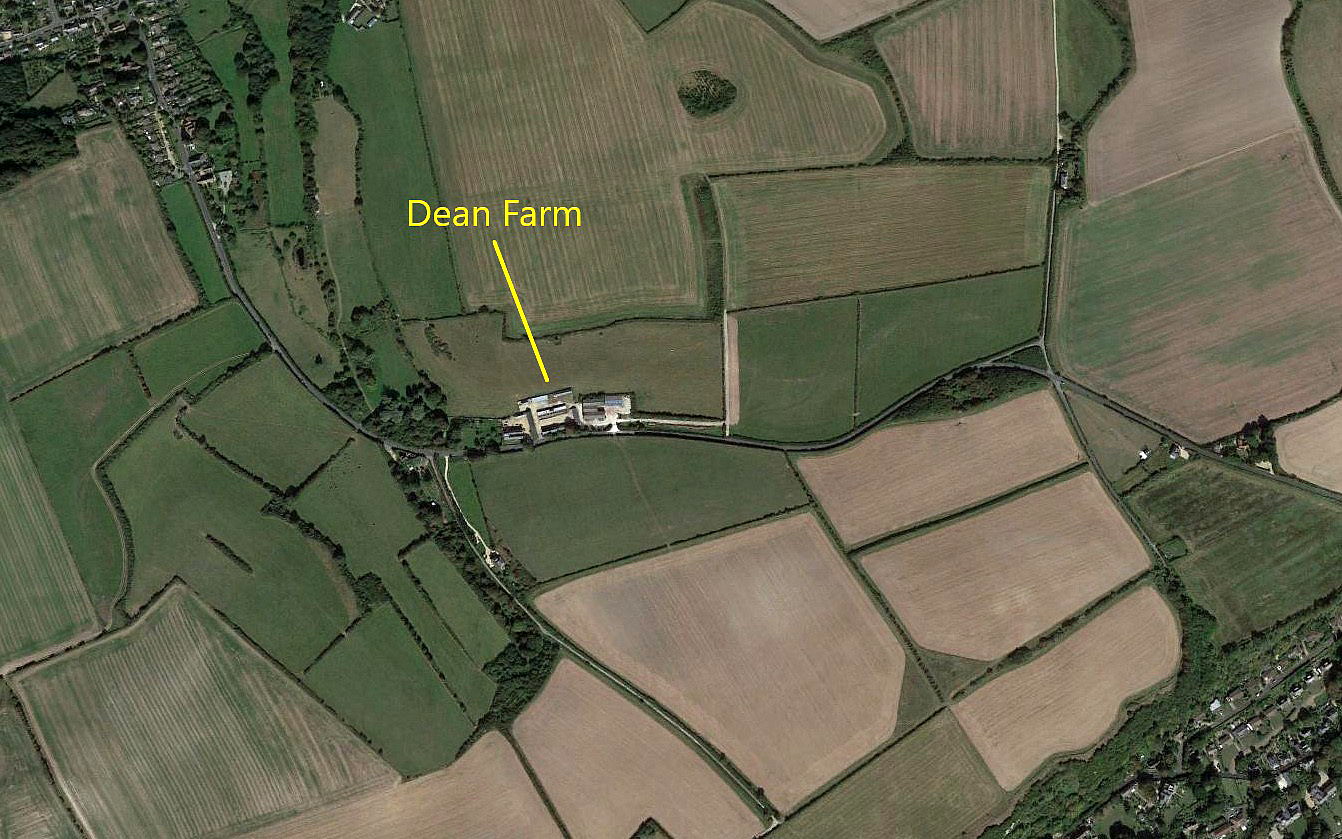St Lawrence aka Ventnor
St LAWRENCE: Flying Field (Aka VENTNOR)
We have to thank Mr Michael T Holder for putting in all the research for this entry, plus providing maps and pictures, and seeking permission to use the fabulous pictures from the Ventnor Heritage Museum.
Location: About 1nm WSW of Ventnor town centre, on the south side of the Isle of Wight
Period of operation: Not known? Two 'Flying Weeks' were held here in the summer of 1911. The first event started on the 5th July 1911, and was really quite successful. The second 'Flying Week' was something of a disaster with two machines being wrecked and a third ditching whilst en route.
The first 'Flying Week' in July was organised by Mr B W Judd of the Royal Marine Hotel in Ventnor. Perhaps the second event probably involved people of the Aviation Committee in Ventnor town council, also with no knowledge of aviation. This venue was described by one aviator as being a 'death trap' - and he was not exaggerating! Indeed, it seems incredible that none of the aviators were killed. The first problem being that it was situated on a cliff edge, and any breeze springing up, even a light breeze, would have presented serious problems.
What we today need to remember is that the top speed in level flight of these biplane machines was about 40 mph. (Monoplanes were a tad faster of course). In other words they were never flying far above the stalling speed! (As indeed modern airliners are at high altitude). Any form of gust or down-draught could easily overcome the machine's ability to fly, especially when close to the ground. Which is why, in those days, most flying was done in the early morning or evening, when - in the summer at least - wind conditions are most likely to be calm.
NOTES: We do not know how many aviators used this 'Flying Field' in 1911, but so far evidence has been found that Mr Collyns Pizey, Mr Gordon England, Mr Henry R. Fleming, Mr. James Valentine and, last by certainly not least, Mr. Robert B. Lorraine.
Needless to say, despite being wealthy to a lesser or greater extent, all the early pioneer aviators seem to be great characters. It was one thing to just fly locally from say, BROOKLANDS, HENDON or EASTCHURCH, (others of course were also forging ahead all over the U.K.), and quite another to embark on cross country flights.
For example Robert Lorraine (1876 - 1935) was a well known London and Broadway stage actor, actor-manager and had also been a soldier. Also being a pioneer aviator was pretty much a side-line of his. He was also famous in 1911 for making the first Marconi wireless message from an aeroplane!
A LOT WAS GOING ON IN THE SUMMER OF 1911
Mike Holder sent me this precis of what he has discovered relating to these 'Flying Weeks'.
"Saturday 01 July 1911. Collyns Pizey with H.R. Fleming as passenger, (my note: Fleming was also a pilot having achieved his certificate in April), started from Lark Hill at 03.30 enroute to Eastchurch via Brooklands to witness the Gordon Bennett Cup Race. Due to unfavourable weather conditions they landed at a farm 3 miles from Basingstoke at 04.15. (My note: Adjusting clocks for BST (British Summer Time) wasn't introduced until 1916, therefore advancing the time two hours ahead of the 'real' time, GMT (Greenwich Mean Time)."
"At 0450 they resumed the flight and landed at Brooklands where they found that Mr Gordon England who was to have accompanied them had made it to Eastchurch. Pizey and Fleming refuelled and proceeded on only to be forced down by poor weather conditions again, at Rochester. (My note - typical English summer weather!). Gordon England flew back from Eastchurch to Rochester to join them. (My note: We don't know where they landed, the ROCHESTER aerodrome we know today wasn't opened until the 1930s). Early on Sunday 02 July the two aircraft pressed on for Shoreham. They descended at Uckfield where the aviators were entertained to breakfast at the Agricultural College."
"Gordon England got airborne again and flew to Haywards Heath where thanks to a downdraught he ended up in the adjacent Convent Grounds and had the aircraft carried across to his own field at Oakwood." (My note: See OAKWOOD entry - this wasn't Gordon England's field - just one he presumed he could use without permission) "He flew back to Uckfield at 2130 where the following morning - Monday 03 July 1911 - at 0530 they all departed for Shoreham. On Wednesday 05 July 1911 - they all departed for St Lawrence Flying Field at Ventnor. On 07 July 1911 at 0500 Fleming and Pizey departed for Bristol." (My note - presumably FILTON).
A ST LAWRENCE GALLERY
These pictures were kindly provided by the Ventnor Heritage Museum via the Rev. J. Hibberd.
BONUS PICTURE
MUCH, MUCH MORE
Mike Holder had been delving once again into the newspaper archives and found some more accounts. In effect showing that despite the best efforts, the later efforts were pretty much an utter shambles. As might of course be expected in those early days.
"James Valentine had a car accident on his way down from London - fortunately no one was injured but he failed to fly on Friday 18 August 1911. He flew successfully in Saturday 19 August, making four brilliant flights."
"Mr Valentine left the flying ground on Monday 21 August for Shoreham via Brighton where he circled over the Palace Pier." (My note - I've done that too - see my article, 'The view from above').
Note: Mike Holder has kindly provided this map which he prepared, showing the routes Collyns Pizey and Gordon England took in August.
From the Globe Tuesday August 1911. Precis by Mike Holder
"The flying week began disappointingly - neither Pizey nor Gordon England arriving. Pizey got to Cowes after leaving Salisbury at 17.45 on the Monday 14 August but had to delay the completion of his journey with darkness coming on. He left at 05.20 on Tuesday 15. Gordon England reached Newport and was continuing on to Ventnor on Monday 14 August when he had a forced descent, crashed and sustained injuries. Mr Valentine is expected today, Tuesday 15 August. (My note: So - it seems, Valentine arrived four days late!)
But of course we need to remember just how communications worked in those days. The telegraph system was well established, at certain places, but telephones were few and far between. The mail system was very effective over short distances, especially in cities. You could post a letter in London in the morning and expect a reply that same afternoon.
Mike also found extra information from the Isle of Wight County Press and South of England Reporter.
"The committee, (my note: presumably on Ventnor town council?), entered into a contract with Bristol and Continental Aeroplane Company for the supply of two biplanes which were to give daily exhibitions of flying throughout the week." (My note: Was this company an off-shoot of the British and Colonial Aeroplane Company, at FILTON, soon to use the Bristol logo?). Other aviators had also promised to attend."
NOT A GOOD START - NO AIRCRAFT!
"Monday 14 August 1911 was a beautiful day with glorious sunshine and hundreds made their way to the flying ground at St Lawrence - but they were disappointed. No aircraft!"
"Pizey and England had reached Amesbury on Salisbury Plain, (my note - LARK HILL, often referred to as Amesbury, the nearest town), on the Sunday - 13th August - but due to adverse weather conditions had remained overnight. The conditions did not abate on the Monday until the evening when both aircraft made successful take-offs. They crossed the Solent to the west of Southampton, reaching the Isle of Wight well to the west of Gurnard."
My note: LARK HILL, on Salisbury Plain, was the site of the British and Colonial Company's flying school, and one of their main bases. Gurnard is just to the west of Cowes on the north coast.
Note: Map and both pictures provided by Mike Holder.
"Pizey landed about 19.15 in a field just below the Horseshoe Inn at Northwood - his engine was overheating. A large crowd gathered and many pressed Pizey for his autograph which he duly obliged. England who was 20 minutes behind him, passed overhead and the crowd cheered him as he signalled Pizey that he was going on. At about 19.45 Gordon England's machine was seen approaching and he passed over the eastern part of the town, (Newport presumably?), but there was an ominous cessation to the sound of the motor - his petrol had run out - he descended "gracefully" and landed in a field above Little Pan Farm. The owner - Mr H W Adams offered England overnight accommodation, but England was determined to press on to Ventnor. Mr Arthur Pring had volunteered to cycle to Newport and get some petrol which only took a jiffy."
My note: Aircraft of that era had no flying instruments, no compass, and certainly no petrol gauge. Guessing the duration available from the limited amount those small tanks could carry, (see pictures), was very much pure guesswork - even if backed by considerable flying experience. Also of course, even a slight head-wind which the pilot would be unable to estimate, (or even be aware of?), would seriously shorten the range over the ground.
To some extent pilots could get some idea of the general wind direction by observing the smoke from chimneys, (all dwellings had either wood or coal burning fires and stoves), but the wind gradient and direction can change quite a bit even at 100ft above the ground. Plus of course, local wind patterns on the ground can be affected in all sorts of ways, by woods for example and the nature of the local terrain. Flying cross-country in those days really was quite a perilous business.
Navigation over land was, as often as not, dictated by following railways. Pilots often said they flew by 'Bradshaws', then a popular railway guide and timetable. But, in those days there were a great many more railways than today, with branch lines frequently peeling off. Large rivers were a great boon, but we only have a few in the UK. And, even these tend to meander all over the place. Just look at a map to see how useless following the Thames could be for direct cross-country flight at low level.
Note: Both the map and picture were kindly provided by Mike Holder.
GETTING GOING AGAIN
"By now about 2000 people had gathered but with the help of PC Randall and a number of men linking arms an area was cleared for take-off and England departed at 20.40*. He made a graceful circuit in the direction of Staplers Farm and continued southwards: as he was flying over St George's Down - in his own words, "I was tossed about by the strong winds and I found I had made little progress so decided to descend. I commenced the descent and a sudden gust of wind drove me downwards. The Biplane struck the earth violently and I was thrown out on my face, sustaing a bad cut across my nose from the wires of the machine. My teeth were driven through my lips." OUCH!" as Mike puts it.
My note: * Must have been almost dark by then. Also, most aviators and their passengers rarely used even the most basic form of restraint to keep them from being thrown out in a crash, or even in unexpected severe turbulence.
Note: The map and picture kindly provided by Mike Holder.
"This occurred in a turnip field just to the right of the roadway near Merston Cross. A Mr Rayner took the very dazed England to the Royal Marine Hotel in Ventnor where he was able to give the Aviation Committee an account of what had happened to himself and Mr Pizey after they left Amesbury."
My note: Wot! Not to a hospital? They were hardy folks in those days.
Note: This map and picture was also kindly provided by Mike Holder.
MR PIZEY RESUMES HIS FLIGHT
"Mr Pizey resumed his flight at 20.00 from Northwood and was seen passing over Newport on the Carisbrooke side. Darkness was falling and he was running short of fuel, so he decided to descend, and he successfully alighted on the high land at Rowridge above Rowborough and stayed at the Red Lion at Carisbrooke. A PC Bungey guarded the machine and at 05.00 on Tuesday - 15 August - Pizey resumed his flight to Ventnor which he reached around 05.15. He passed over Ventnor and out to sea before turning back towards St Lawrence and the landing field. Flying very low, Pizey headed towards the little fort, (marked as Battery on the map), and as he passed over it a huge downdraught caused by a strong northerly wind, dashed the aircraft into the cliff. The brambles and ivy saved the airman from injury and he was able to scramble out of the machine onto terra firma."
My note: How lucky can you be? If that ledge of sorts hadn't been there, the results would almost certainly have been fatal had the machine hit the cliff face and tumbled down.
"The machine was badly wrecked, (see first picture above), and was recovered to the top of the cliff. The committee had now been robbed of both aircraft, (My note: from Bristol), and the mechanics went to work on the machines to try and make one complete machine from the two; it proved to be beyond their skill."
My note: Hardly surprising I suppose as the front of both machines had been trashed.
EXTRA PICTURES FROM THE VENTNOR HERITAGE MUSEUM
My note: The first and second pictures are of a Bristol 'Boxkite' type. Not sure about the fourth picture - possibly also a 'Boxkite' type?
BUT, ALL WAS NOT LOST
"Shortly after 08.00 on Tuesday 15th, Mr James Valentine arrived on his monoplane from Brooklands, an hours flight - and he made a "splendid" descent. However, there was to be no more flying that day while the northerly wind caused severe turbulence over the landing field."
My note: Even today, pilots of light aircraft with so much better performance and handling, still come to grief with unexpected wind shear, rotor effect from woods and large buildings, etc, etc. Valentine arriving so soon from BROOKLANDS must have had a fairly strong tailwind pretty much all the way down.
A TELEGRAM
"Later that day the committee received a telegram from Mr Oscar C Morrison stating that he had left Folkestone for Ventnor on his monoplane; however, he did not appear. In the evening the wind died down and Valentine was persuaded to make an ascent just after 19.00 which placated the crowd who went home in a more amiable mood. Unfortunately, Valentine elected to land at a field near Whitwell - probably near Dean Farm - but none the less, the crowd had seen some flying."
My note: It seems to me that Valentine was a pretty shrewd aviator, and had decided that the venue at St Lawrence was far too risky.
"Meanwhile news had leaked that Mr Morrison had met with disaster. Off Sandgate, (My note: Just west of Folkestone), his engine began to misfire and then stopped. The aircraft dropped into the sea a short distance from the shore: fortunately, the aircraft was buoyant, and a boat arrived and towed the aircraft back to Folkestone where it was hauled up the beach."
Note: Both of these maps and the picture were kindly provided by Mike Holder.
"Mr Valentine refused to fly from the St Lawrence Field after Tuesday night, so permission was obtained from Mr Attrill of Dean Farm to use a suitable field there. He offered to undertake daily flying for the sum of £50; on the Saturday - 19th August - the last day of Ventnor Week. Valentine gave flying exhibitions in the morning, aftenoon and evening. Ideal weather conditions prevailed, and the airman flew inland and along the coast to Shanklin. He encircled Ventnor Pier and received an ovation from the passengers on the pleasure steamer Bournemouth Queen, and the crews of the tugs in the in the bay emphasising the applause of the people."
My note: Those civilian and naval tugs would have been at anchor, without much if any doubt, in the bay near Shanklin and Sandown, waiting to assist large vessels. Navy ships for Portsmouth and merchant ships for Southampton. In those days large ships had very limited ability, virtually none, to manouevre within docks, so the assistance of tugs was a necessity.
"Valentine departed on the Monday, 21st August . He had a hearty send-off, and he flew to Brighton, encircled the pier and then proceeded to Shoreham where he landed some 40 minutes after take-off."
JAMES VALENTINE
A name barely remembered today, in his short time as a pilot, he really was a master aviator. A very quick learner of the primitive arts of aviation. He gained his Royal Aero Club certificate on the 31st December 1910 at BROOKLANDS. But in the next year, 1911, flying a Deperdussin, he was one of only four pilots to complete the Daily Mail Circuit of Britain race. He was the only British competitor in the Circuit of Europe race, and one of very few to complete the course.
He joined the Royal Flying Corps in 1914 and was eventually sent to take part in the Russian campaign. He died of wounds on the 7th August 1917 in Kieff, Russia, now Kiev in the Ukraine, and was buried in an unknown grave. He was 29 years old.
JUST ONE MORE SMALL ASPECT
As can be seen in some of the pictures above, the Royal National Hospital would have provided the aviators with a perfect waypoint for the Landing Ground. It was opened in 1869 for chest diseases - mainly tuberculosis - which was a major scourge until after WW2. In effect it was an isolation facility. It closed in 1964 and was demolished in 1969.
We'd love to hear from you, so please scroll down to leave a comment!
Leave a comment ...
Copyright (c) UK Airfield Guide















